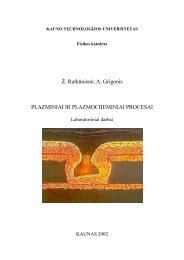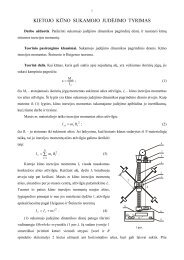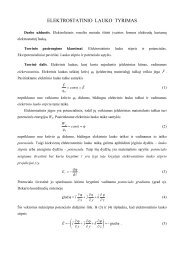PROCEEDINGS OF THE 7 INTERNATIONAL ... - Fizika
PROCEEDINGS OF THE 7 INTERNATIONAL ... - Fizika
PROCEEDINGS OF THE 7 INTERNATIONAL ... - Fizika
Create successful ePaper yourself
Turn your PDF publications into a flip-book with our unique Google optimized e-Paper software.
N. Kazuchits et al. / Medical Physics in the Baltic States 7 (2009) 76 - 78<br />
3. Results and discussion<br />
Temporal dependence of current for several γ-rays<br />
137 Cs dose rates for the synthetic diamond detector is<br />
shown in figure 1a. For comparison, the similar<br />
characteristic for IIa-type natural diamond detector is<br />
shown in figure 1b. For both detectors maximum<br />
irradiation dose rate is equal 6,02 сGy/s and bias<br />
voltage is 30 V.<br />
As shown in figure 1, both detectors require preirradiation<br />
dose about 10 Gy for current stabilization.<br />
Requirement of pre-irradiation is character feature of<br />
all types of diamond detectors and related to trapping<br />
of charge carriers on the local states in the band gap of<br />
material. It is necessary to note that sensitivity of<br />
synthetic diamond is about 20 times higher than that of<br />
natural diamond. Nevertheless, the synthetic diamond<br />
detector current fluctuations are higher and reach the<br />
value about 3%.<br />
Fig. 1. Temporal dependence of current for several γ-rays<br />
137 Cs dose rates for synthetic (a) and natural (b)<br />
diamond detectors<br />
Knowledge of the detector dose rate response is of<br />
importance for accurate dosimetry. Figure 2 shows<br />
such dependences for both types of detectors under the<br />
γ-rays irradiation of 137 Cs source.<br />
For natural and synthetic diamond detectors this<br />
dependence is close to linear and can be approximated<br />
by the equation [5]:<br />
i = i0 + RD ∆ , (1),<br />
where i - detector current, i0 - detector current without<br />
irradiation (dark current), D – the dose rate, R –<br />
sensitivity, and ∆ - linearity index.<br />
Fit of the dependences in figure 2 with expression (1)<br />
with fitting parameters R and ∆ gives ∆ = 1,011,<br />
R = 0,1 μC/Gy, and ∆ = 0,978, R = 1,7 μC/Gy for<br />
natural and synthetic diamond respectively.<br />
77<br />
Fig. 2. Dose rate dependence of current for natural and<br />
synthetic diamond detectors under γ-rays 137 Cs source<br />
exposure<br />
The suitability of the synthetic diamond detector for γrays<br />
registration was investigated by measuring depthdose<br />
curves and profiles in 6 and 18 MeV scanning<br />
photon beam of “Varian” linear accelerator. Relative<br />
dose rate distribution measurements by both PTW<br />
natural diamond and synthetic diamond detectors were<br />
carried out in water phantom. Detectors were placed<br />
perpendicular to the beam axis.<br />
Depth-dose curve of a 6 MeV photon beam measured<br />
by the PTW natural diamond detector is presented in<br />
figure 3.<br />
Fig. 3. Depth-dose curve of a 6 MeV photon beam measured<br />
by PTW natural diamond detector<br />
It was not possible to obtain such dependence for<br />
synthetic diamond detector because of its current<br />
exceeds maximum threshold of used PTW registration<br />
equipment.<br />
For this reason further dose rate distribution<br />
measurements were carried out while detectors were<br />
submerged in water phantom on depth of 150 mm.<br />
Radiation field distribution is shown in figures 4 and 5<br />
for natural and synthetic diamond detectors<br />
respectively. Parameters of registered radiation field<br />
are presented in table 1. As shown in figure 5, synthetic<br />
diamond detector measurements with integration time<br />
of 0,5 s are characterized by higher signal fluctuations<br />
in comparison with natural diamond detector. Such








